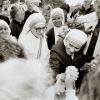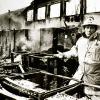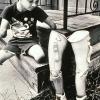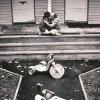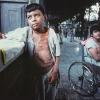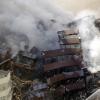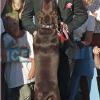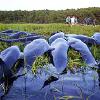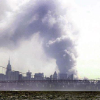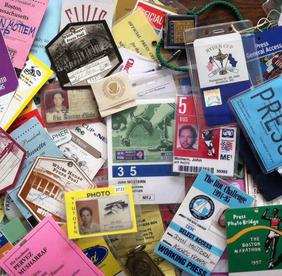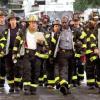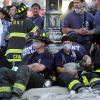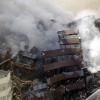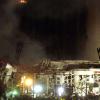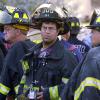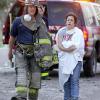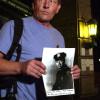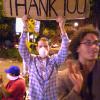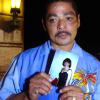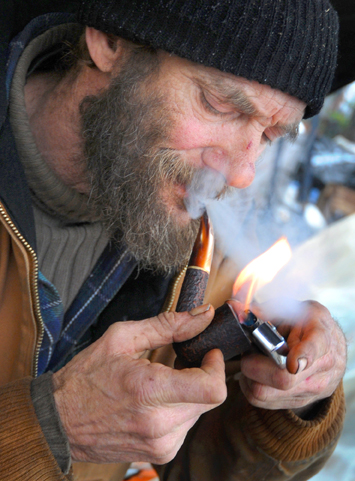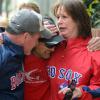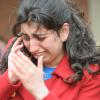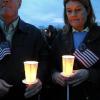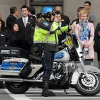John Mottern is an award-winning international photographer covering major stories, sporting events and advertising projects for editorial and commercial clients. His 35-year career as a photojournalist started at The Boston Globe in the late 80's, continuing as a contract photographer for Agence France-Presse until 2007. He is currently freelancing as a commercial/editorial photographer and also directing/producing/shooting documentary video projects around the world.
Boston Marathon Bombings
Agence France-Presse
Cover photo
PEOPLE Magazine
Camp Runamuck - East Providence Homeless community -Homeless in America
By John Mottern
Barbara Kalil and her husband John Freitas co-founded Camp Runamuck in late March, 2009 after being forced to leave their campsite in the Roger Williams State Park in Providence, Rhode Island. Barbara said that they lived under a plaque which read “Shelter for persons in distress.” It was very clear that the irony stood as a slap in the face to this unemployed nurse. “…the park ranger was really great to us but one day the Preservation Committee found us while on a tour and were horrified to see our tent. We had to leave because we didn’t want the ranger to get in trouble.” Now Barbara and John live under a bridge with about 25 other homeless people all residing in an assortment of tents, many covered with tarps for added protection. This makeshift village is located under a cathedral like series of immense cement arches and pillars of the Washington Bridge which is part of highway 195 in East Providence.
Barbara, who appears to be in her late forties, lives in a tent very close to the Seekonk River. She glides slowly back and forth in her rocking chair flanked by several pink flamingos and other lawn ordainments. The pink sharply contrasts her blue nurse’s pants, scrubs left over from the job she lost before becoming homeless. The walls of the bridge are covered with graffiti art depicting castles with armies, large faces and quotes. The place feels like a contemporary art gallery that you might stumble across down a side street in Chelsea. “This is much better than the shelters which are unclean and unsafe” She says. This sentiment was shared by many in the tent city.
“It’s getting more difficult because people are bringing less donations and they are scared to come down here after the stabbing incident a few weeks ago. Churches seem to bring less because they’re under presser from the community (at large) not to help us.” This odd collection of people, living on the fringe, have chosen to take their chances as a loose clan operating with few rules. There seems to be a level of security through the power in numbers and the watchful eyes of the overall group. “It’s simple. We take care of each other.” says Kalil.
Katie is 19 and would only give her first name. She wears a bright colored, t-shirt and a mini skirt that would make any teen’s father crazy. Her tattooed belly and pierced lip are strangely elegant. She is a pretty girl who lives in Camp Runamuck with her boyfriend. “I’ll never be a materialistic person again in my life. I will not be greedy.” She says. “You can put a 100 people together, blacks and whites, gays, drug addicts who are completely different but we all get along because we’re stuck in the same position. We all get bit by bugs.” The inside of Katie’s tent is clean and organized. A single condom lies on the shelf next to a prescription bottle. “I’ve never had to wash my clothes by hand.” Katie is hoping for a spot in a couples’ shelter or to qualify for Section 8 housing. She pointed out that there are 59,000 homeless people in Rhode Island. “I’m looking for a job but you have to have an address to get one. What am I going to say? I live in a tent.”
E D I T O R I A L
9/11 World Trade Center Attack / Agence France-Presse
Portfolio of Images
John's photographs have been published in virtually all major newspapers and many prominent magazines around the globe. He has covered presidential campaigns, wars, natural disasters, terror attacks, social conflicts, major league play-offs, fashion/society events while being contracted to produce a wide variety of VIP portraits.
American flag is starkly taped on the pillar in the center of the kitchen area. Therrien says he learned to cook from his grandmother at age 13 while she was working in a restaurant. He makes sure there is breakfast and dinner for the full population every day using mostly donated supplies. “The Board of Health came and checked us out and said that since we had a dumpster everything was fine with our kitchen. It was great because the donated dumpster, which is now emptied every week, arrived at the same time The Board of Health people showed up.” Needless to say there is no running water or electricity, water always being in short supply. “We always need ice, water, charcoal, and food supplies.” Therrien lost his job and was living with his daughter in a situation which became impossible so he moved to Camp Runamuck where he has lived since May.
Bruce Yeoman and Wayne Strobel have lived together in a small dome tent in Camp Runamuck for two months. They are battling substance abuse and are more typical of the stereotypical homeless person and are currently the minority in the camp. “I brought this on myself with alcohol.” Says Yeoman, “I either sleep or drink. I say tomorrow is not another day…but we have each other’s back, Wayne and I.” “The shelters are dirty and dangerous and they are always telling you what to do.” He adds. “I found Bruce sleeping in the woods before we came here. This is much better and we got each other.” said Strobel. Yeoman then describes how aggressive behavior upfront keeps him safer against people that will hurt him. He demonstrates by pushing his body and face against me inadvertently letting me inhale a stale whiskey gale generated from the previous nights adventures.
Although Camp Runamuck is represented by an attorney donating legal services it’s residents are suppose to leave the State owned property by September 8th through court order. This will mark the closure of the last of three tent cities in the providence area which have already been hauled away in dumpsters. There was talk of moving the camp to reservation land claimed by the Seaconke Wampanoag Tribe in Cumberland, Rhode Island but the area is a superfund site which has raised legal and health issues. The diversity of Camp Runamuck illustrates the impact current economic times are having on those living to close to the edge in America. Young and old, blue collar workers and professionals are appearing in greater numbers in these tent cities after loosing jobs and homes. “Homeless” no longer means alcoholics, drug addicts, and the mentally ill but apparently includes many who’s options have just plain run out.
Ed Therrien who is unemployed and a resident is also the unofficial cook for the camp. He runs the outdoor kitchen which sits at the far end of the camp and like any other restaurateur his work is never done. There is a disjointed collection of canned and dried food stuff, bottles, pots and pans gathered at the cement base of one of the giant bridge pillars that rises about eighty of feet in the air. There are a variety of barbeque grills, coolers, and tables used for food preparation under the grand canopy of cement. It is actually awe inspiring architecture which gives the place a holy and surprisingly calm effect. A large
Front Pages:
New York Times
The Washington Post
USAToday
The Boston Globe
Miami Herald
Herald Tribune
LATimes
Chicago Tribune
Washington Times
Baltimore Sun
Philadelphia Inquirer
Charlotte Observer
Toronto Star
PEOPLE Magazine
-more








